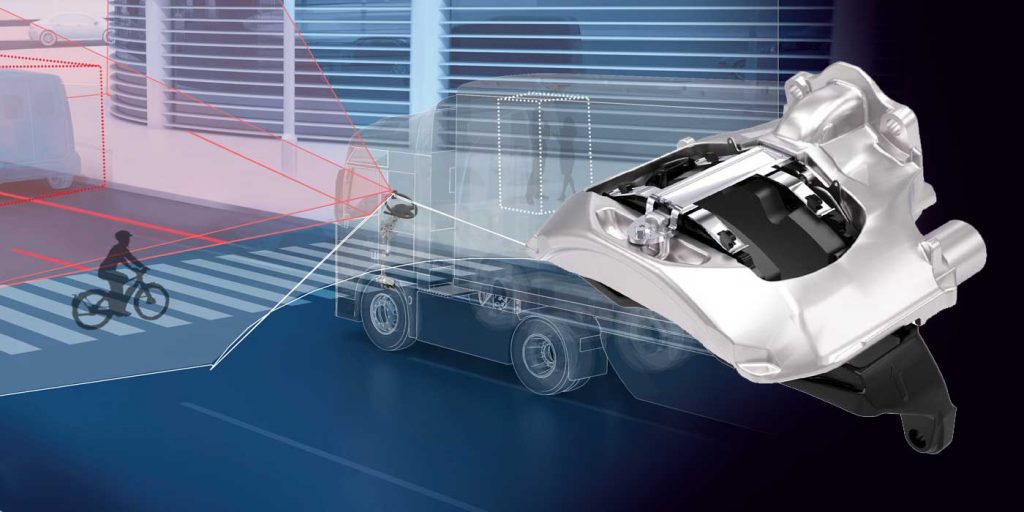Level 2 automation has been a game-changer in terms of safety for about a decade now, and manufacturers continue to churn out better versions of this technology every year.
Active steering, automatic emergency braking—you’ve heard the terms and you have a good sense of what they do, but how do the companies behind this technology actually make it work? And what needs to happen before companies can produce the next upgrade?
That’s what we’re here to find out.
Level 2 101
Level 2 safety systems are developed with the goal of mitigating collisions and enhancing the driver experience through automated assistance. Level 2 advanced driver assistance systems can control both steering and braking/accelerating simultaneously under certain circumstances, like adaptive cruise control, collision mitigation and lane departure warning. This is different than Level 1 systems, which can only sometimes assist the driver with either steering or braking/accelerating, but not simultaneously (think standard cruise control).
OEMs have embraced this technology not only as a way to reduce collisions, but as an enticing recruitment feature for many new drivers. You may have heard of Volvo Active Driver Assist (VADA) 2.0—which is now standard on new Volvo trucks (the VNR, VNL and VNX) starting with the 2020 model year – and Detroit Assurance 5.0, available on model year 2020 Freightliner Cascadia trucks. These are Volvo’s and Daimler Trucks North America’s latest suites of Level 2 safety systems.
What makes Level 2 automation possible
These systems work by integrating software with the truck’s hardware, primarily radar, cameras and brakes. Through this marriage, Volvo’s VADA 2.0, which was developed in partnership with Bendix, is capable of features like improved Automatic Emergency Braking (AEB), Adaptive Cruise Control with Cruise Auto Resume (ACC) and Highway Departure Warning and Braking (HDB).
Editor’s Note: For a full list and explanation of these features, Fleet Equipment wrote an FAQ on the VADA 2.0 which you can read below.
“The camera acts as a second set of eyes with a 42-degree-angle field of view. The radar detects metallic objects and the camera identifies the object and confirms if it is eligible for Automatic Emergency Braking (AEB),” says Ash Makki, product marketing manager for Volvo Trucks North America. “The improvement of the AEB, Adaptive Cruise Control (ACC) and Highway Departure Warning and Braking (HDB) relies on improving the capability of the radar and the camera, and minimizing false positives through validation. The current VADA 2.0 AEB is capable of bringing a fully-loaded Volvo truck from a speed of 50 MPH to 0 to mitigate, or possibly eliminate, a rear-end collision.”
Detroit Assurance 5.0 also includes a variety of features that include Adaptive Cruise Control to 0 MPH, Side Guard Assist, and Active Lane Assist, which includes Lane Keep Assist and Lane Departure Protection. In previous iterations of Detroit Assurance (2.0 and 4.0), the features were either radar- or camera-based; the features Detroit Assurance 5.0 is capable of are only possible due to the careful melding of radar and high-definition camera technology.
Fleet Equipment also wrote an FAQ on Detroit Assurance 5.0. For a full list and explanation of these features, read the story below.
At NACV 2019, Bendix announced forthcoming Wingman Fusion upgrades in hardware and software to support a host of new Level 2 automation technologies like Traffic Jam Assist, Highway Assist, Pedestrian/Cyclist Alerts, Lane Keeping Assist and Lane Centering, which we can expect to see within the next two years. While details on exactly how these systems will work have yet to be released, TJ Thomas, director of marketing and customer solutions—controls at Bendix Commercial Vehicle Systems, shares that allowing steering functions to be part of the company’s driver assistance suite will involve integrating the Wingman Fusion with the truck’s torque overlay systems.
He says that a flexible, yet redundant design in these systems should be expected.
“The keys are building blocks and redundancy; when you’re on the pathway to highly automated driving, you need to put in place systems that can be upgraded and ones that can provide redundancy between the brake and steering systems,” Thomas says. “The systems we’re working on today have to be flexible enough and built correctly to allow the future enhancements. Flexible architectures need to be designed so they can build on and augment each other to enable new features going forward.”
ZF’s Farid Khairallah, engineering director of commercial vehicles ADAS, also stresses the importance of redundancy in the company’s dual-cam two-lens camera, which is capable of features such as Lane Change Assist, Automatic Emergency Braking and Traffic Jam Assist.
“The use of sensor fusion between camera and radar is important in verifying the vehicle environment and making safety decisions. Relying on a single sensor is not as robust as having the camera and radar sense the environment and compare the data of each around every 40 milliseconds (the blink of your eye is typically 200 milliseconds or more) to help ensure that a safety function is triggered when needed,” Khairallah says. “For example, a lane change assist system can use side-facing radar and cameras to confirm that there are no vehicles in the blind spot or in too-close proximity to safely allow for the lane change. Similarly, with functions like Traffic Jam or Highway Driving Assist, the sensor fusion gives you more confidence in making high-level safety decisions like implementing collision mitigation or emergency braking if the driver is not responding.
“Camera and radar fusion give the system added robustness to false positives and reduces operational risks. For example,” he continues, “the camera sends surrounding information to the radar regarding overhead structures such as bridges and tunnels to help eliminate false targets – or to improve the distance accuracy in unique, specific scenarios, such as lumber sticking out of the back of a truck – that could be invisible to radar and poses risk during close AEB or ACC maneuvers, and thus the two sensors complement each other in effective system operation.”
The brakes will make or break Level 2
If you ask Collin Shaw, North American director of business development and marketing for ZF’s newly formed Commercial Vehicle Control Systems Division, to unravel the magic that makes automated safety systems work the way they’re supposed to, he’ll give you a relatively non-magical sounding answer: It’s in the braking system.
“As fleets and OEMs approach us about Level 2, they’re normally focused on ADAS,” Shaw says. “[They ask] for a set of Level 2 sensors and cameras that can perform Level 2 autonomy. “We have the unique ability to look at the entire system, from Level 2 capabilities and ADAS to the core elements of the systems’ components that enable that performance, which really starts with braking architecture.”
And, he says, the more advanced Level 2 automation systems become, the more important the choice of braking system on the truck.
He points to adaptive cruise control—particularly its ability to work properly in stop-and-go traffic—as a prime example.
“Adaptive Cruise Stop-and-Go is probably one of the most requested features we have from OEMs and fleets. Everybody is talking about it today. And as we look at braking systems, your standard ABS braking system really isn’t able to deliver that type of performance,” Shaw says. “You’re going from a system that is really just required to stop the vehicle as fast and as hard as possible to avoid the collision while maintaining longitudinal control to a system that is going to bring the truck to a stop very similar to how the driver would do it. So the functionality and the finesse of the system really changes when you go from that dynamic of collision mitigation and avoidance to driver assist.”
Shaw says ZF’s Modular Braking System Platform (mBSP), released in 2018, was built with the idea of laying the foundation to support the advanced functions necessary for autonomous, driver-assist driving.
For more on today’s Level 2 automation, click here to read Tips on getting drivers used Level 2 automation and click here to read Is Level 2 automation the future of fuel efficiency?













